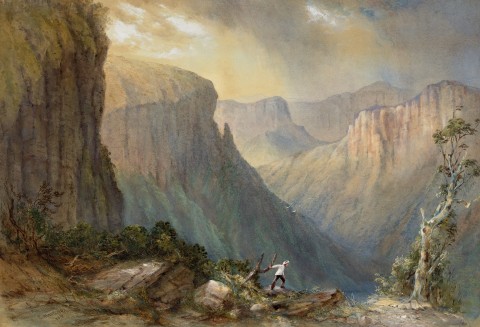GOVETTS LEAP, 1876
CONRAD MARTENS
watercolour and gouache on paper
44.5 x 64.5 cm
signed and dated lower left: C. Martens. / 1876
William Busby Esq., New South Wales, acquired directly from the artist, 28 July 1876
Thence by descent
Private collection, New South Wales
Thence by descent
Private collection, New South Wales
Conrad Martens Account Book, 1856 – 1878, Mitchell Library, State Library of New South Wales, Sydney (as ‘Govets [sic.] Leap Wm. Busby £21.0.0’)
de Vries–Evans, S., Conrad Martens on the Beagle and in Australia, Pandanus Press, Brisbane, 1993, pp. 196, 202, and in supplement p. 31 (as ‘Govett’s Leap’)
Ellis, E., Conrad Martens, Life & Art, State Library of New South Wales Press, Sydney, 1994, p. 187 (as ‘Govet[t]s Leap’)
Govett’s Leap, showing Mount King George. 1874, pencil on paper, 28.5 x 46.0 cm, inscribed with date and title lower left: ’Govets [sic] Leap December 16. 1874’ and upper centre: ’N.E. Mt King George’ in Conrad Martens Sketchbook, Volume 02: Conrad Martens sketches from the Blue Mountains, Lithgow and Capertee, 1873–76, Mitchell Library, State Library of New South Wales, Sydney, accession number: ZPXD 307 Vol. 2, f.6
Govett’s Leap, looking south east. 1874, pencil on paper, 28.5 x 46.0 cm, inscribed with date and title lower left: ’Govets [sic] Leap December 16. 1874’ and upper right: ’SE’, in Conrad Martens Sketchbook, Volume 02: Conrad Martens sketches from the Blue Mountains, Lithgow and Capertee, 1873–76, Mitchell Library, State Library of New South Wales, Sydney, accession number: ZPXD 307 Vol. 2, f.7
The most significant landscape artist working in Sydney in the mid nineteenth century, Conrad Martens first witnessed the breathtaking geological formations of the Blue Mountains a few short weeks after his arrival in Sydney on 18 June 1835. He had intended only to visit Australia but soon recognised the rich opportunities for artistic inspiration and a potential market in the burgeoning colony of New South Wales. It was reported on 31 July 1835 that ‘a gentleman of the name of Martin’ was travelling ‘in search of the picturesque’, which he soon found amid the towering sandstone escarpments and the seemingly endless forested valleys of the ranges.1 Martens sold his first view of Govett’s Leap, near Blackheath, as early as 6 August, with similarly impressive natural landscapes forming an important part of his oeuvre from that time.2
In December 1874, Martens, then in his seventies and having travelled widely throughout eastern NSW and southern Queensland, undertook another trip to the Blue Mountains. This decision may have been prompted by recent public recognition he had received. In 1873 the Trustees of the new National Gallery of Victoria commissioned a watercolour, One of the falls on the Apsley, for their developing collection. The following year a variant view of the spectacular gorges of the Apsley River, in the northern tablelands of NSW, was commissioned for the New South Wales Academy of Art (later Art Gallery of New South Wales).3 The interest provoked by these important acquisitions may have encouraged Martens’ return to the increasingly accessible Blue Mountains for further inspiration and opportunities. A number of paintings resulted, including depictions of the recently opened trainline, which paved the way for the establishment of new townships and ever-expanding tourism.4
Fortuitously many of Martens’ sketchbooks survive, including that from his 1874 journey which shows his route and demonstrates his superlative draughtsmanship. Two pencil studies of Govetts Leap, drawn on 16 December, are included – one of which was most certainly the source for the watercolour being offered here.5 In the study we see his meticulous attention to the topography of the terrain and strata of the columns, positioning himself so that a damaged gum tree counterbalances the nearest cliff-face, framing the scene and leading the viewer’s eye along the meandering valley. The painting is similar but has been enhanced for picturesque effect. We can no longer see the top of the left cliff and are thus immersed within the dramatic scene. Martens’ use of blues and purples for the shadowed valley enhances the sensation of vast depth, which is further highlighted by the tiny figure in white who provides scale and, by holding carefully to a branch as he peers tentatively over the precipice, encourages an understandable sense of awe in the ‘wild magnificence’ and ‘wonderful natural sublimity’ of the New South Wales escarpments.6
Marten’s Account book, kept throughout his career, provides invaluable information about his output and his clientele. This watercolour was acquired by William Busby, a pastoralist and parliamentarian, in July 1876 for £21 – it has remained with the family ever since.
1. ‘Domestic and Miscellaneous Intelligence’, The Australian, 31 July 1835, p. 2
2. Sold to J. Macarthur. Martens painted oils and watercolours of the same scene in 1837, 1839 and 1847.
3. One of the falls on the Apsley, 1873, watercolour, collection of the National Gallery of Victoria, Melbourne and Apsley Falls, 1874, watercolour, collection of the Art Gallery of New South Wales, Sydney. These were based upon pencil sketches made when Martens visited in 1852.
4. The trainline first ran as far as Weatherboard in July 1867; see Conrad Martens, Crossing the Blue Mountains, Deutscher and Hackett, Sydney, 12 Sept. 2007, lot. 65
5. See Related works above.
6. John Oxley, upon sighting the Apsley Falls; see Oxley, J., Journals of Two Expeditions into the Interior of New South Wales, John Murray, London, 1820, pp. 296, 299
ALISA BUNBURY
